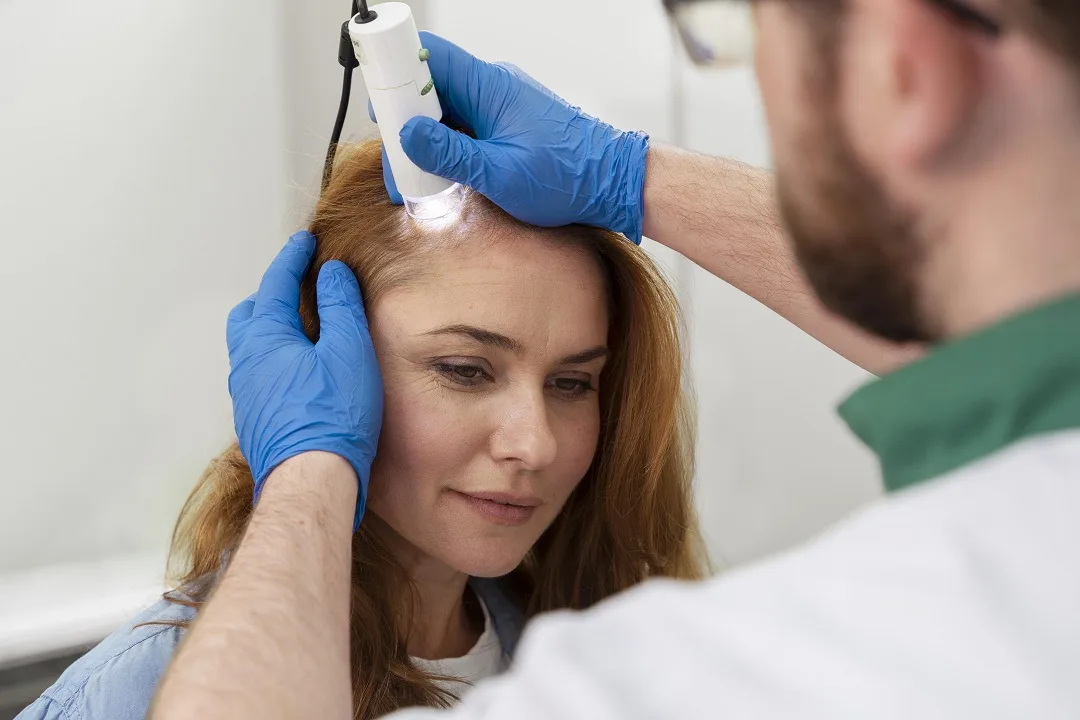Advances in hair restoration technology have made modern treatments available to people seeking successful treatment. Two ways to promote hair growth and correct hair loss are modern non-invasive treatments and surgeons. This article discusses the latest developments in hair restoration and smart suggestions for dealing with hair loss problems.

- Advanced hair restoration procedures offer effective solutions for hair loss.
- Technological advancements have made hair restoration treatments more reliable and natural-looking.
- Individualized treatment plans are crucial for optimal results in hair restoration.
- Combination therapies such as PRP therapy and micro needling can enhance the outcomes of hair restoration procedures.
- Consulting with a qualified specialist is vital to determine the most suitable hair restoration approach for each patient.
Types of Advanced Hair Restoration
It is crucial to understand the different types of advanced hair restoration techniques available to address varying degrees of hair loss. These options, which include both surgical and non-surgical techniques, each have special advantages for people looking to get back to growing hair on their own.
Surgical Methods
With advancements in technology, surgical procedures such as PRP Therapy have become increasingly popular for those looking for a more permanent solution to hair loss. These techniques entail transplanting hair follicles from a donor location to areas where there is baldness or hair thinning. Hair restoration has undergone a revolution with to techniques like Follicular Unit Extraction (FUE) and Follicular Unit Transplantation (FUT), which produce outcomes that are remarkably natural-looking and leave little scarring.
Non-Surgical Methods
On the other hand, non-surgical methods offer less invasive options for people who are hesitant about surgical procedures. These methods include topical treatments, laser therapy, and platelet-rich plasma (PRP) injections to stimulate hair follicles and promote hair growth without surgery. Although results may vary, non-surgical methods can be an effective solution in the early stages of hair loss or complement surgical procedures. The demand for non-surgical hair repair methods has increased due to their convenience and minimal downtime. These treatments are usually performed in a clinical setting by trained professionals who specialize in hair restoration. Patients can expect a gradual improvement in hair thickness and density over time, and regular treatments are recommended for best results.
Breakthrough Treatments
It is clear that advances in hair restoration have led to the development of breakthrough treatments that offer innovative solutions to hair loss. From stem cell therapy to hair cloning techniques, these cutting-edge treatments aim to treat hair loss at the cellular level, stimulate new hair growth and improve overall hair quality. Although some of these treatments are still in the experimental stages, they hold great promise for the future of hair restoration. To stay informed about the latest hair restoration treatments, it is important to consult with a qualified professional who can assess your specific needs and recommend the most appropriate treatment options. Thanks to continued research and technological advances, the landscape of advanced hair restoration continues to evolve and offer hope to people struggling with hair loss. Consider Before Choosing a Hair Restoration Method
Degree of Hair Loss
Before choosing a hair restoration method, you need to assess the degree of hair loss. Different methods are suitable for different stages of hair loss, so understanding where you fall will narrow down your options and ensure you choose the most effective solution.
Lifestyle and Recovery Time
Hair restoration methods vary according to lifestyle requirements and recovery. Some methods may involve little downtime and fit seamlessly into your routine, while others may require more significant changes and recovery time. Consider how much time you can devote to the recovery process and how it will affect your daily life. The lifestyle changes and recovery time of different hair care methods should fit your schedule and preferences. Before making a decision, it is important to consider the impact on your daily routine and responsibilities.
Long-Term Maintenance Requirements
Assuming you want a permanent solution to hair loss, you need to consider the long-term maintenance of the chosen method. Some treatments may require regular follow-ups, special products or special care instructions to maintain results. Understanding these requirements beforehand will help you decide if the method is sustainable for you in the long term. In order for your restored hair to last a long time, it is very important to follow the recommended maintenance schedule and care instructions. Before deciding on a method, consider whether you are willing and able to commit to the maintenance required to maintain the results over time.
Cost and Budget Considerations
On top of the initial cost of the hair restoration method, it’s vital to factor in any additional expenses associated with ongoing maintenance or follow-up treatments. Consider your budget and financial flexibility when choosing a method to ensure you can afford both the upfront investment and any long-term expenses that may arise.
Maintenance costs can vary depending on the method chosen and the individual’s specific needs. Before undertaking any hair restoration procedure, make sure you have a clear understanding of the total costs involved, including possible additional costs.
Step-by-Step Guide to the Hair Restoration Process
Initial Consultation
At the first consultation, you will meet with a hair restoration specialist who will assess your hair loss and discuss the goals of the procedure. This is a crucial step in the process, as it allows the specialist to determine the best course of action for your individual needs.
| Initial Consultation | Discuss goals and assess hair loss |
Pre-Procedure Tips
Consultation is key in understanding the procedure and setting expectations. During your consultation, be prepared to discuss your medical history, current medications, and past hair treatments. Knowing this information will help the specialist create a treatment plan that fits your needs.
- Ensure to follow any pre-procedure instructions provided by your specialist
Before undergoing the hair restoration procedure, it is important to prepare yourself mentally and physically. Understanding the procedure will help ease your anxiety and ensure you are fully prepared for what to expect on the day of your treatment.
Understanding the Procedure
Preparing for the hair restoration procedure involves familiarizing yourself with the steps involved and the expected outcomes. It is important to clearly understand the procedure, including the techniques used and the recovery schedule.
| Understanding the Procedure | Familiarize yourself with the steps and expected outcomes |
| Understanding the Procedure | Familiarize yourself with the steps and expected outcomes |
Pros and Cons of Different Hair Restoration Techniques
All hair restoration techniques come with their own set of pros and cons. For those considering haircuts, it’s important to carefully evaluate the options available before making a decision. This chapter discusses the pros and cons of different technologies so you can make an informed choice.
Evaluating Surgical Techniques
For those looking for more permanent solutions, surgical hair restoration techniques such as follicular unit transplantation (FUT) and follicular unit extraction (FUE) offer promising results. FUT involves removing a strip of scalp from the back of the head and extracting hair follicles for transplantation, while FUE involves individually extracting follicles from the donor area.
Weighing Non-Surgical Alternatives
Conservative treatments such as medications, laser therapy, and PRP injections offer noninvasive alternatives to surgical procedures. Although these options may not produce permanent results like surgical methods, they can still help improve the overall health and density of your hair. However, the effectiveness of these treatments varies from person to person and it may take longer to see results. When considering non-surgical options, it is important to consult with a hair restoration specialist to determine the most appropriate treatment plan. to your individual needs. These treatments may require ongoing maintenance to maintain results over time.
Considering Breakthrough Methods
Technologies such as robotic hair restoration and hair cloning are emerging as potential breakthroughs in hair restoration. Robotic systems can help surgeons perform more precise hair transplant procedures, while hair cloning involves reproducing hair follicles for transplantation in a laboratory environment. These methods promise to provide more effective and efficient solutions for people suffering from hair loss. Although these innovative methods are still in the development phase, they have great potential to advance the field of hair restoration and provide innovative solutions for people who seek long-term results. Potential patients should keep up-to-date on the latest advances in hair restoration techniques and consult with a reputable specialist to discuss the options best suited to their specific needs and goals.
Tips for Successful Hair Restoration Outcomes
Although significant improvements can be achieved, it is important to understand that results can vary depending on individual factors such as hair quality, scalp condition and extent of hair loss. It’s important to discuss realistic results with your hair restoration specialist so you have a clear idea of what to expect.
- Follow all pre-procedure instructions diligently to prepare your scalp for the treatment.
- Adhere strictly to post-procedure care guidelines to promote proper healing and maximize results.
Recognizing the importance of these steps can significantly impact the success of your hair restoration journey.
Post-Procedure Care
Assuming you’ve undergone a hair restoration procedure, post-procedure care is crucial for optimal results. Following the instructions provided by your specialist, such as avoiding strenuous activities and keeping the scalp clean, will promote proper healing and minimize complications. Remember that your scalp is in a sensitive state after the procedure, and taking care of it will contribute to successful outcomes.
Follow-Up and Maintenance
There’s a vital aspect of hair restoration that extends beyond the initial procedure—follow-up and maintenance. Regular follow-up appointments with your specialist are necessary to monitor the progress of your hair growth and address any concerns.-In addition, maintenance therapy may be recommended to maintain the results of the initial procedure. Ensuring consistent treatment and monitoring will help you maintain desired hair restoration results in the long term.
Lifestyle changes such as a healthy diet and managing stress levels can also support the health of your hair and scalp. By prioritizing your overall well-being, you can complement the effects of your hair repair treatment and promote long-term success.
Managing Expectations And Psychological Impact
Keeping realistic expectations is crucial when undergoing hair restoration treatments. Although significant improvements can be achieved, it is important to understand that results can vary depending on individual factors such as hair quality, scalp condition and extent of hair loss. It’s important to discuss realistic results with your hair restoration specialist so you have a clear idea of what to expect.
The Emotional Journey of Hair Restoration
An important part of hair restoration is understanding the emotional journey involved. Expectations, fears, hopes and disappointments are all part of the experience. It is common for people to experience different emotions on the road. It is important to be aware of these feelings and, if necessary, seek support from loved ones or professionals.
Expectations play an important role in the emotional journey of hair restoration. Patients often have specific goals and desires in mind when seeking treatment. It is important to communicate these expectations with your hair restoration specialist to ensure they are realistically achievable. Managing expectations can help reduce disappointment and increase satisfaction with overall results.
Emotional well-being is just as important as the physical results of hair restoration. It is normal to experience a range of emotions during the process, from excitement and anticipation to impatience and frustration. Taking care of your mental health and staying positive can have a positive impact on your overall experience and results.
So when it comes to advanced hair restoration, there are effective solutions to help people struggling with hair loss. From innovative treatments like PRP therapy and hair transplant surgery to FDA-approved medications and laser therapy, there are several ways to restore and grow hair. By consulting with a qualified hair restoration specialist, you can determine the best approach for each individual’s unique needs and desired results.
Conclusion
Due to advances in technology and research, the field of hair restoration continues to evolve and offer hope to those dealing with hair loss. . By researching different treatment options and following the latest developments, people can take proactive steps to achieve fuller and healthier hair. Remember that it is important to seek professional advice and guidance when considering hair restoration to ensure safe and effective results.
FAQ
A: Advanced hair restoration refers to the use of cutting-edge techniques and technologies to effectively address hair loss and promote new hair growth.
A: Hair loss can be caused by genetics, hormonal changes, medical conditions, medications, stress, and poor nutrition. Identifying the underlying cause is crucial for determining the most effective treatment approach.
A: Advanced hair restoration solutions include follicular unit extraction (FUE), platelet-rich plasma (PRP) therapy, low-level laser therapy (LLLT), and hair transplant surgery. These treatments are designed to stimulate hair growth and restore a fuller, thicker head of hair.
A: Suitable candidates for advanced hair restoration are individuals experiencing hair thinning or balding, but still have an adequate donor hair supply. It is important to undergo a consultation with a qualified hair restoration specialist to determine the best treatment plan for your specific needs.
Q: Are the results of advanced hair restoration permanent?
A: The results of advanced hair restoration can be long-lasting and, in some cases, permanent. However, individual results may vary based on factors such as the extent of hair loss, the chosen treatment method, and how well the patient follows post-treatment care instructions.











